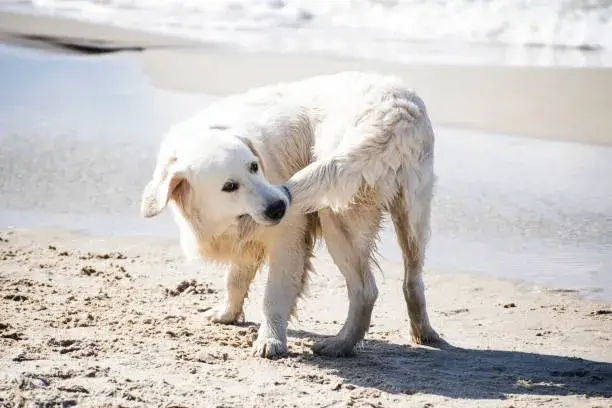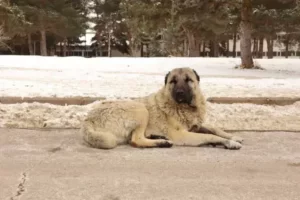Dogs are able to control the movements of their tails. But, most movements are more instinctual. But they are aware they are doing it. But the actual tail wagging is usually done without them thinking about it at first if that makes sense.
Do dogs know their tail is attached to them?
Tail chasing is usually a symptom of boredom or need for attention. It’s self gratifying, like biting your nails. If you encourage a dog to chase it’s tail, it will because they like the attention it brings. They are fully aware that their tail is attached to them.
Can dogs feel the end of their tails?
That’s because the tail DOES have pain receptors, but they do not react the same when relaxed as when excited. By the way, because a dog does not feel pain does not mean they cannot do damage.
Do dogs mind having their tails touched?
While you might think that touching or grabbing onto your dog’s tail is a fun way to play, your dog would sorely disagree with you. Grabbing a dog’s tail—something that children are particularly tempted to do—can be very painful and terrifying for your dog.
Do dogs think their tail is a toy?
Boredom. Oftentimes, dogs will chase their tails because they are a bit bored; it’s a way for them to have fun and expend some energy. This is especially true for puppies, who may not even realize that their tail is actually a part of their body, but see it as a toy. Generally, as dogs age, this kind of play dies down.
Why do dogs chase their tails
Dogs chase their tails for many reasons. This includes: boredom, excitement, dealing with fleas, expelling some energy (especially in puppies), or something serious like an injury. If you think the latter is the case, make sure to contact your vet.
Do dogs know their tail is wagging
While dogs control the movement, they may not always start the wag. It appears they will start wagging out of instinct, not conscious thought, similar to when humans frown.
Why do female dogs chase their tails
They might tail chase when they have internal parasites like tapeworms that have made their way out, she says. “Tail-chasing also occurs when the dog itches around the rear end due to external parasites like fleas or food allergies.
Why do dogs chase their tails when excited
Even outside, dogs get bored of the limited stimulation they receive within the confines of their own backyards. So what do dogs do to amuse themselves or release all that pent-up energy? They chase their tails, providing physical exertion with a side of entertainment.
Why does my dog bite his tail hard
Dogs will chew at a painful area much like people rub an arthritic knee to provide relief. For example, dogs that get their tails caught in a closing door or nick them on a sharp object will chase and chew at their tails to soothe the injury. rear-end due to fleas or food allergies.”
Do dogs feel pain when they hit their tail?
The tail is also filled with nerves and tendons that allow your dog to feel their tail. If you have ever accidentally stepped on your dog’s tail, they will cry out and wince in pain because their tails have nerves and this will give them the sensation of pain if it is hurt of injured.
Why do dogs wag their tails when you talk to them?
Dogs will wag their tail to convey a range of emotions: happiness, nervousness, feeling threatened, anxiety, submission and excitement. It’s thought that when a dog is relaxed, its tail will sit in a resting position. This position will vary depending on the breed of dog.
Why shouldn’t you touch a dog’s tail?
Since the tail is so close to the anus, it can feel extra sensitive and may even breed some insecurity. The reasons a dog may feel sensitive toward having their tail touched don’t have to make sense to us. They may be otherwise idiopathic, but we still need to respect their boundaries.
Can dogs be happy without wagging their tails?
A dog wagging its tail is one example, and we usually read a waggy tail as a sign that a dog is happy. But that’s not the only way dogs can show they’re happy, and there are lots of animals that don’t have tails or don’t use them to talk to each other.
Where do dogs not like to be touched?
Most dogs dislike being touched on top of the head and on the muzzle, ears, legs, paws and tail. Slow petting, similar to gentle massage or light scratching, can calm a dog down. Place your hand on an area where the dog enjoys being handled and gently move your hand or fingers in the same direction the fur lies.
Why does my dog stop wagging her tail when I pet her?
When a dog suddenly stops wagging his tail and freezes, it may mean that he wants divert a threat without being aggressive. Many dogs do this when petted by strangers, to communicate that they don’t want to interact with them.
What happens if you pull on a dog’s tail?
Tail pull injuries can cause damage to nerves higher up in the spinal cord that control urination and defecation. If the nerves that control urination and defecation are injured, your dog may become incontinent. With time, nerve function may return; however, some dogs remain unable to control their bladder or bowels.
What is the purpose of a tail on a dog?
The tail helps the dog maintain his balance by putting its weight on the opposite side of the dog’s tilt, much like a tightrope walker uses the balance bar to stay on the tightrope. Dogs that enjoy climbing various surfaces will use their tails to balance on uneven footing, such as rocks or trees.
Why does my dog hit me with his tail?
With this in mind, it seems that a dog that hits you with his tail is doing so purely by accident. He may be wagging as a reflex, or to express himself, but he is not using it as a weapon or a way to reach out and touch someone like he would his snout or paws.
Can dogs control tails?
Dog’s tails seem to wag on their own, but the muscles that control it don’t. Just like the rest of her body, she can control her tail muscles by thinking in order to manipulate movement. She can wag, lower or raise her tail at will, and she can stop it mid-wag, too.





